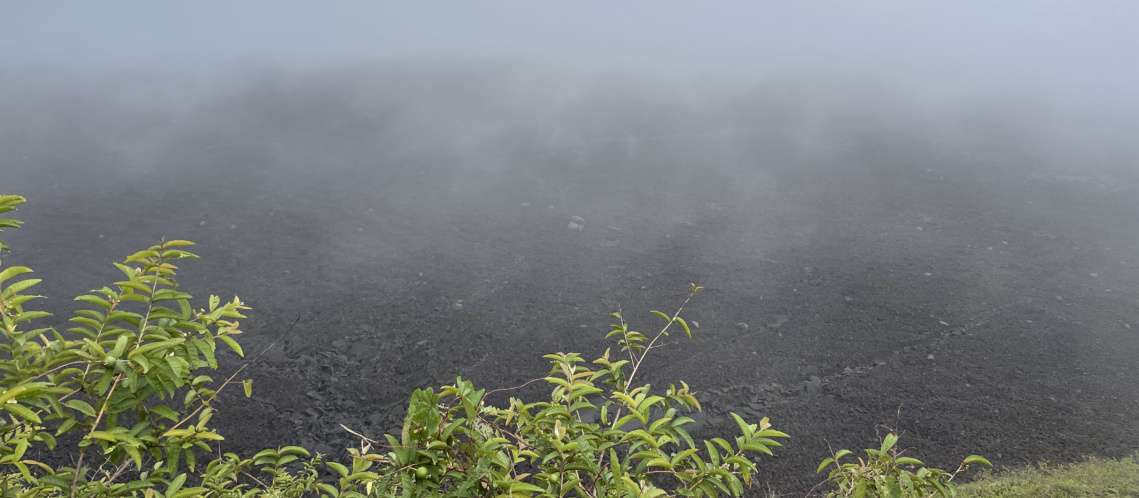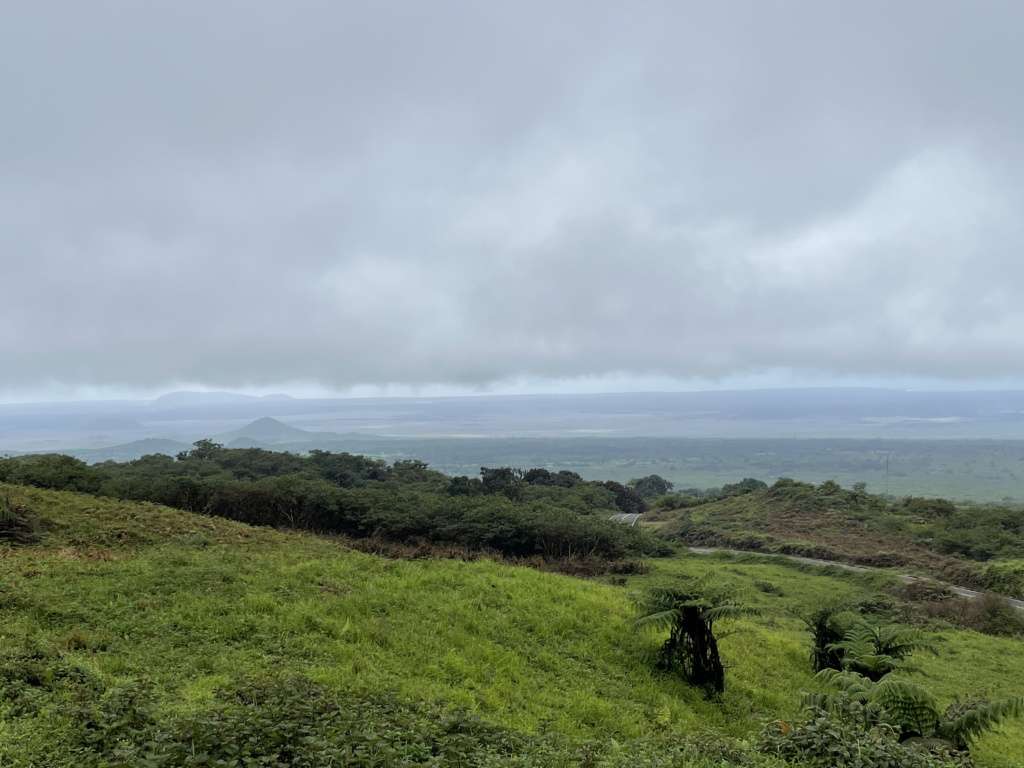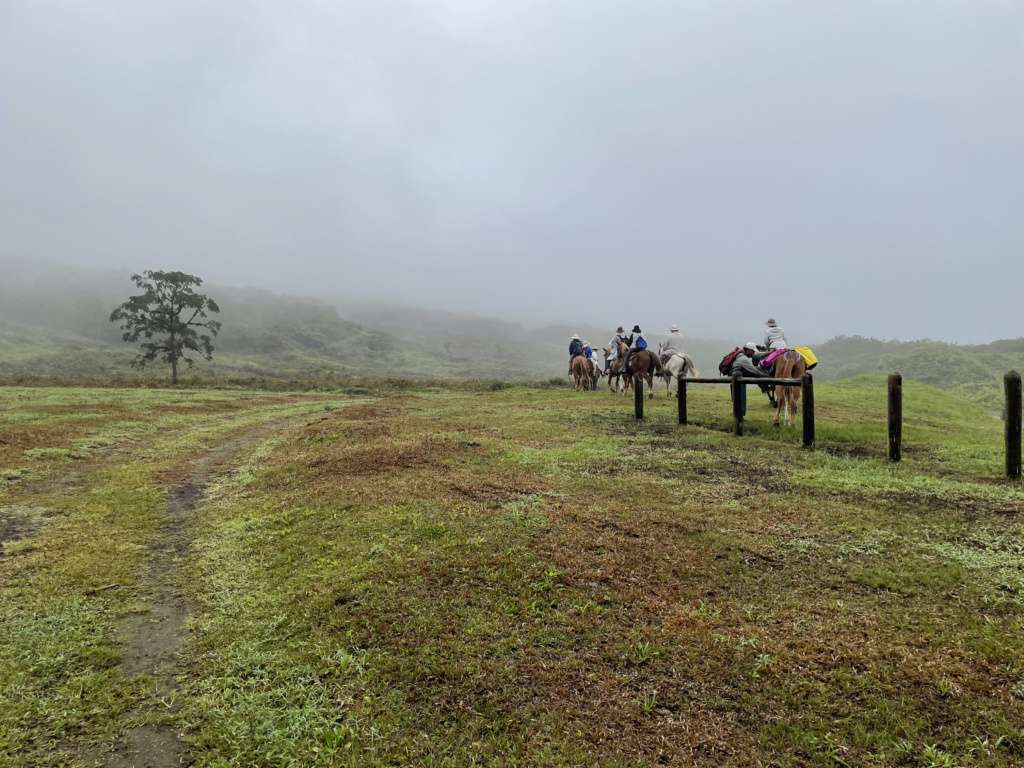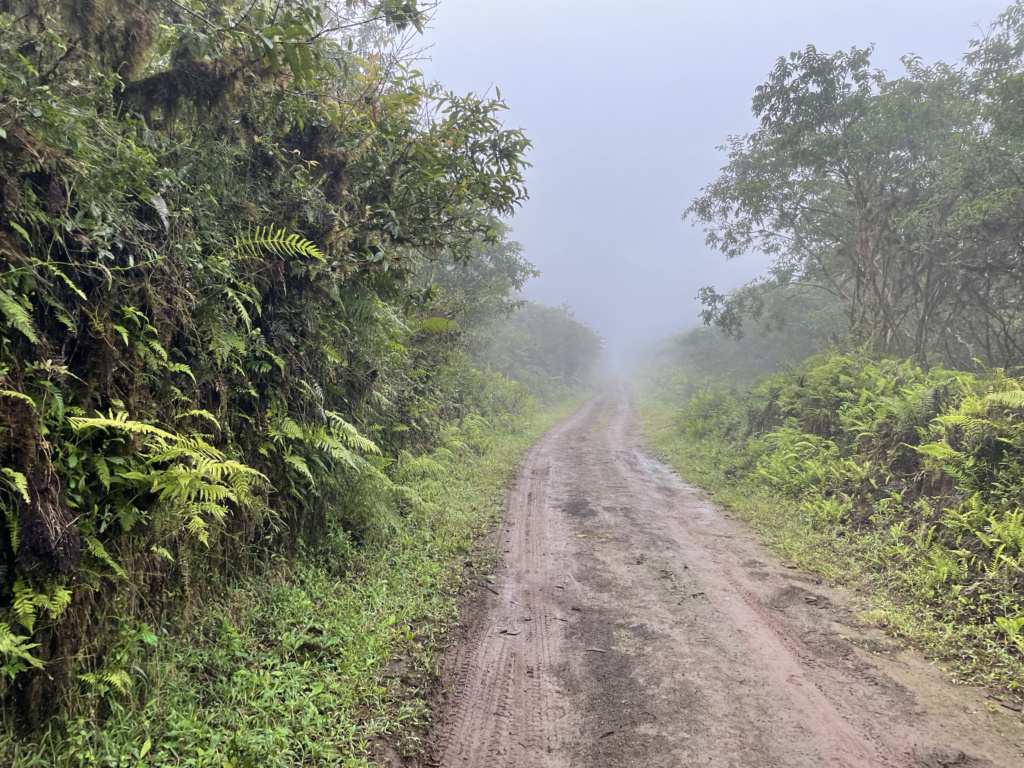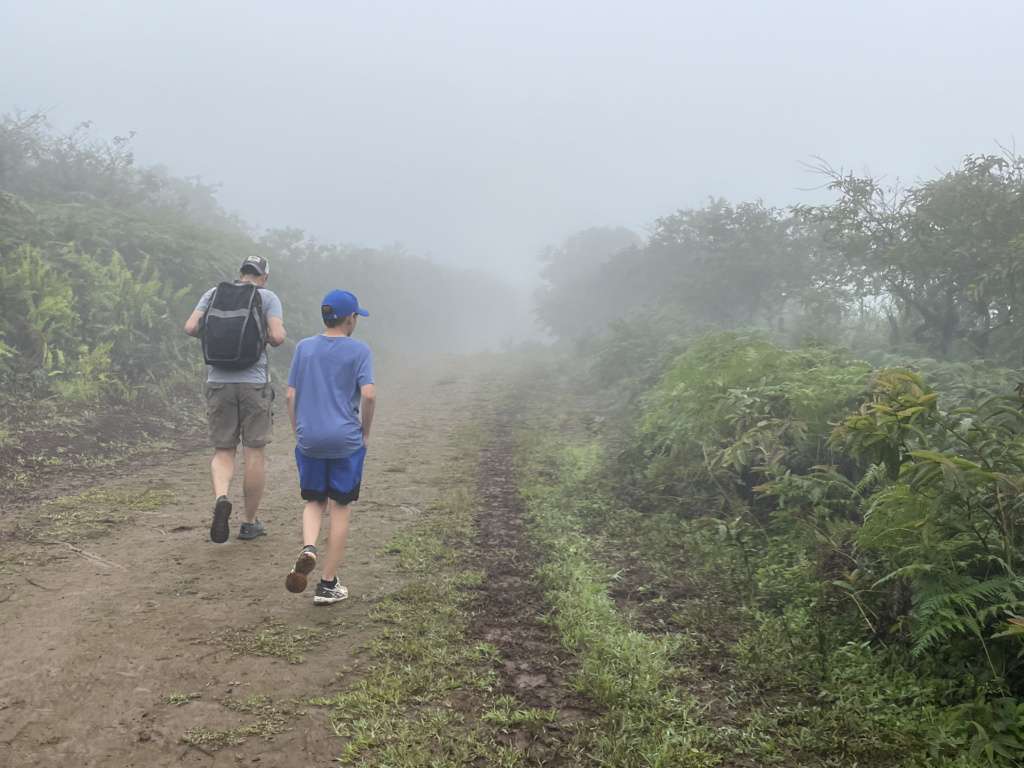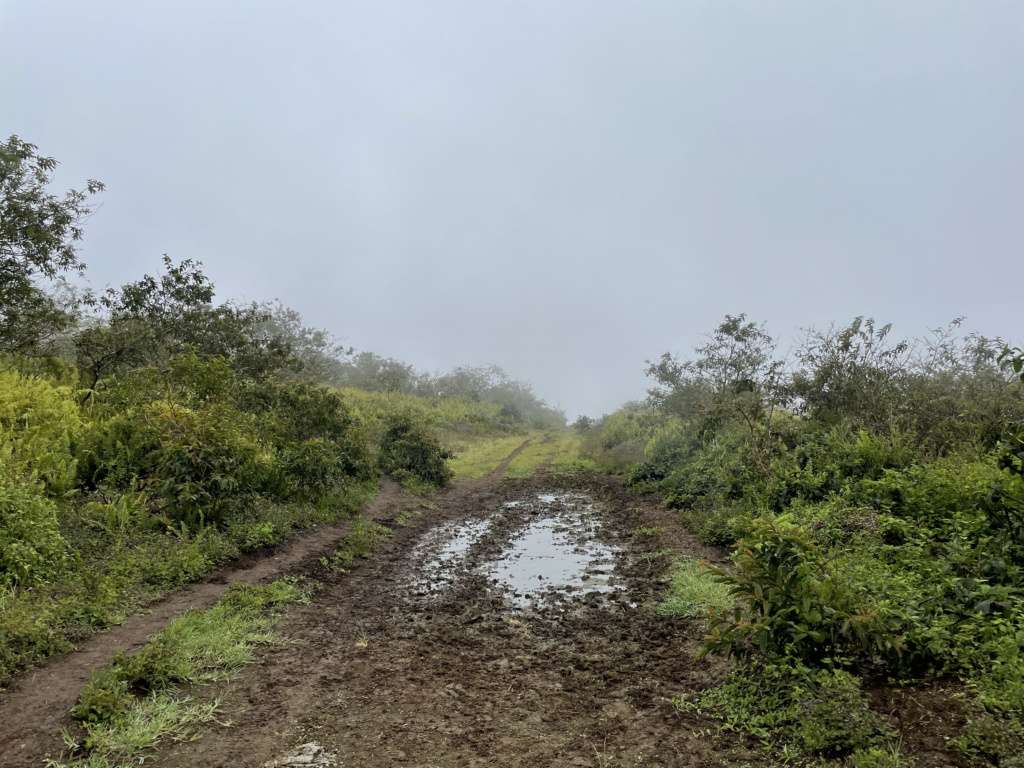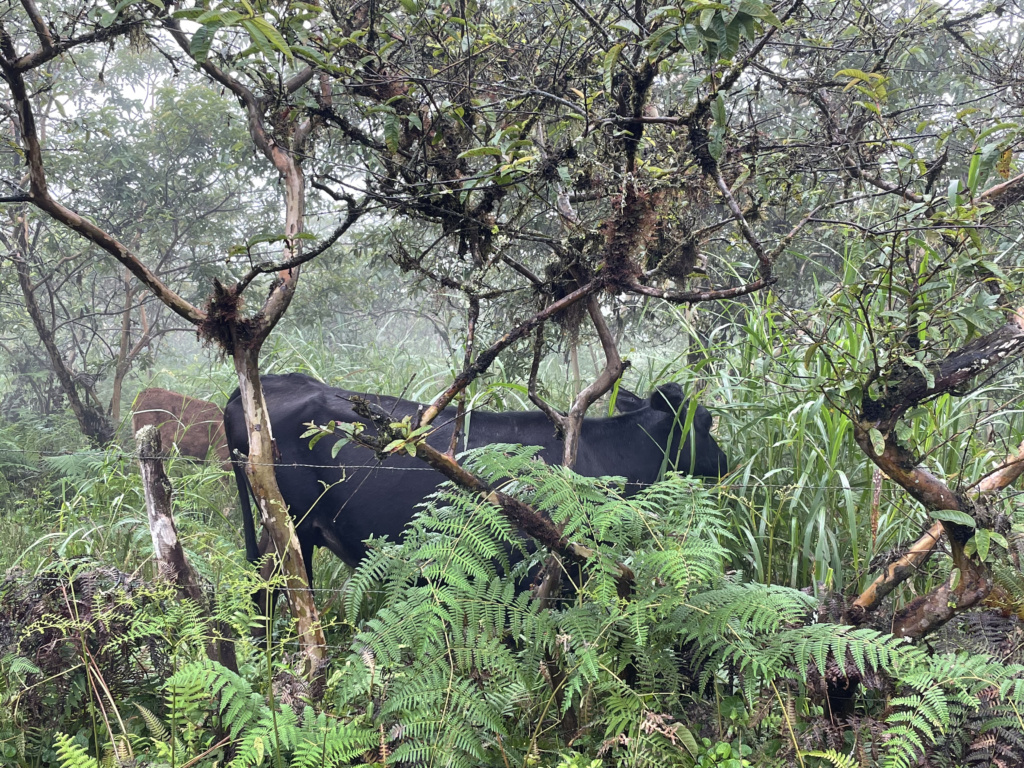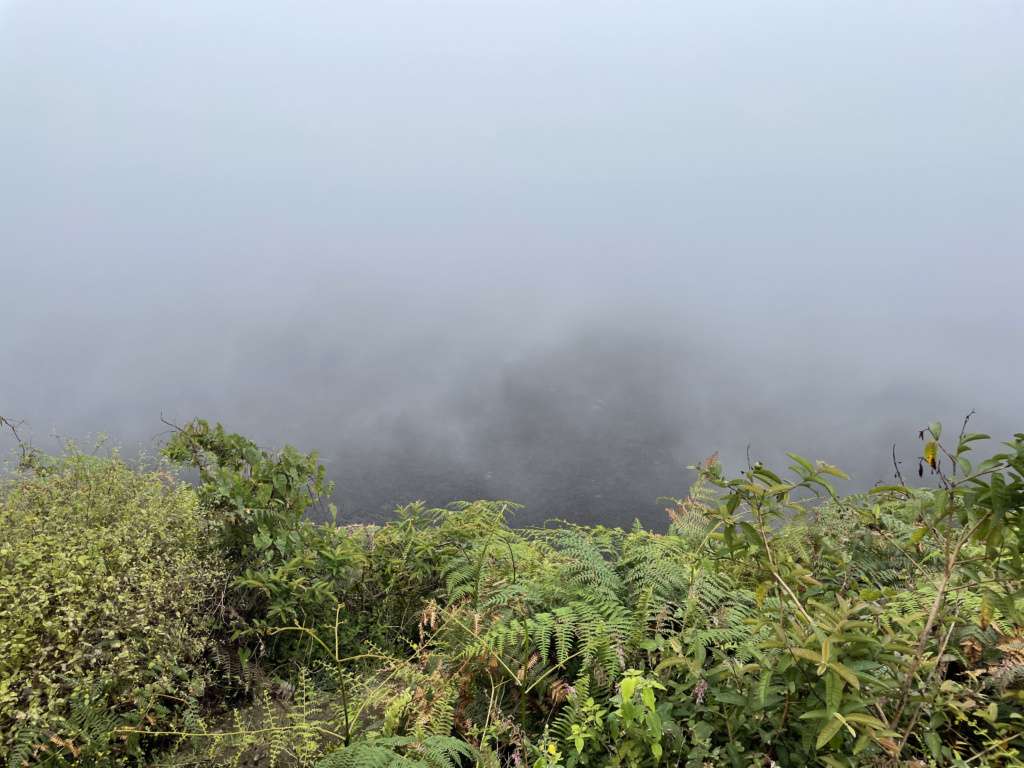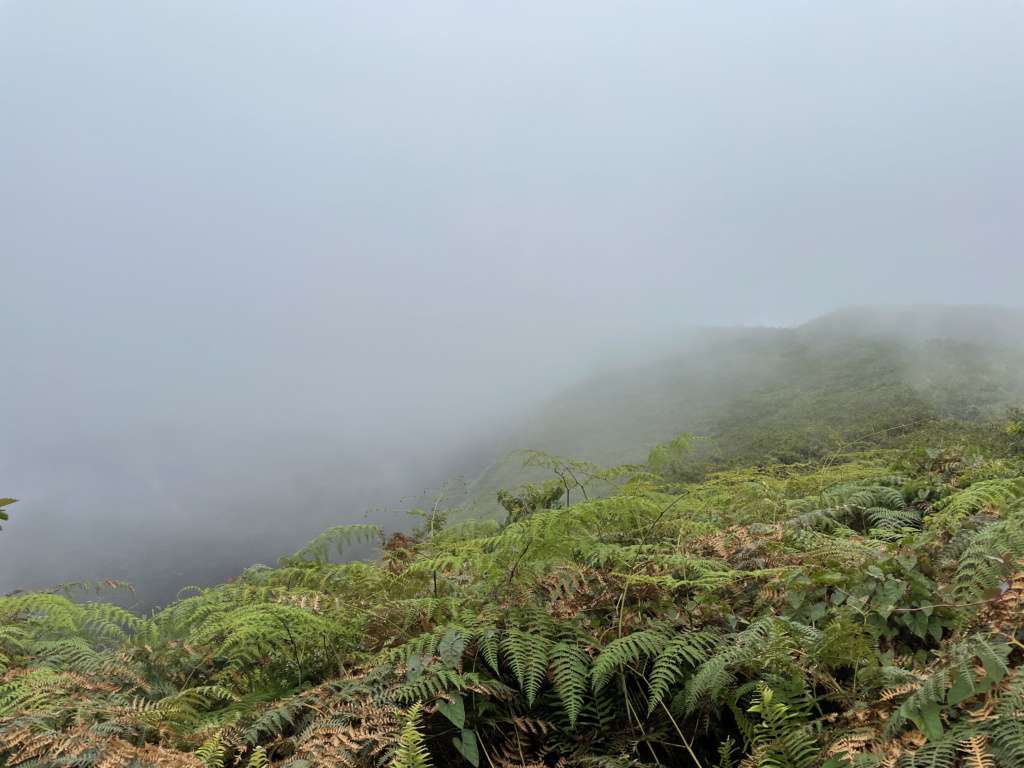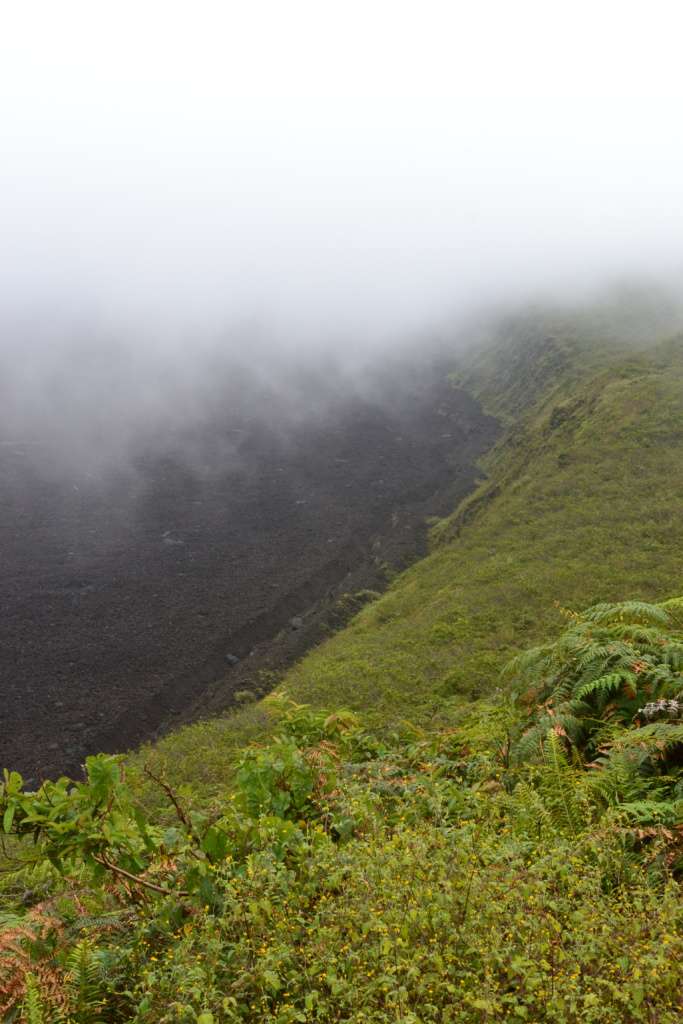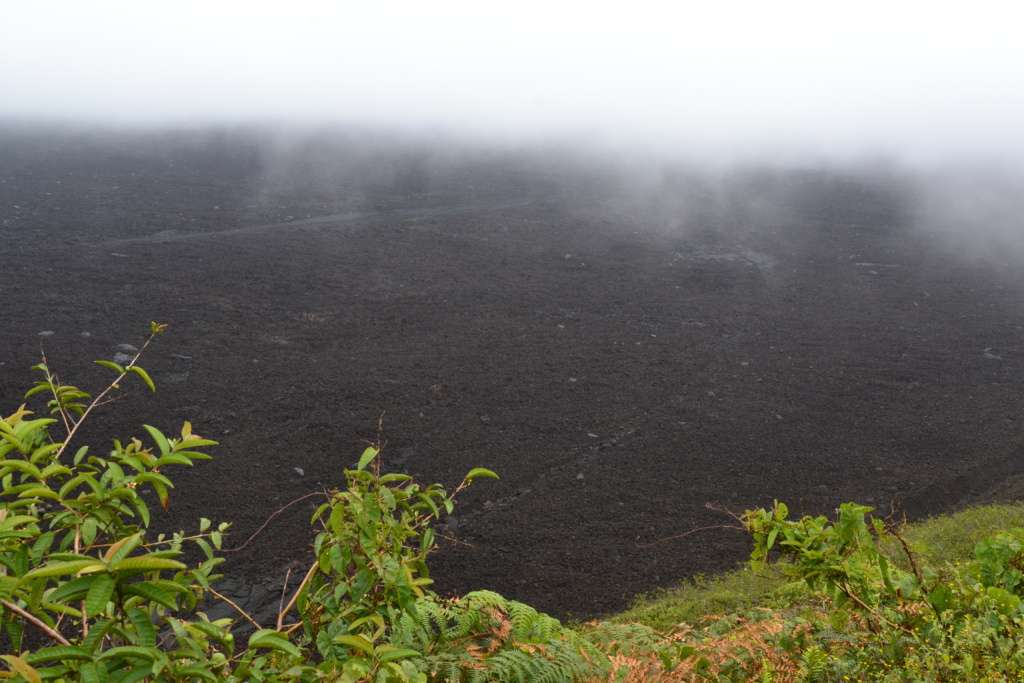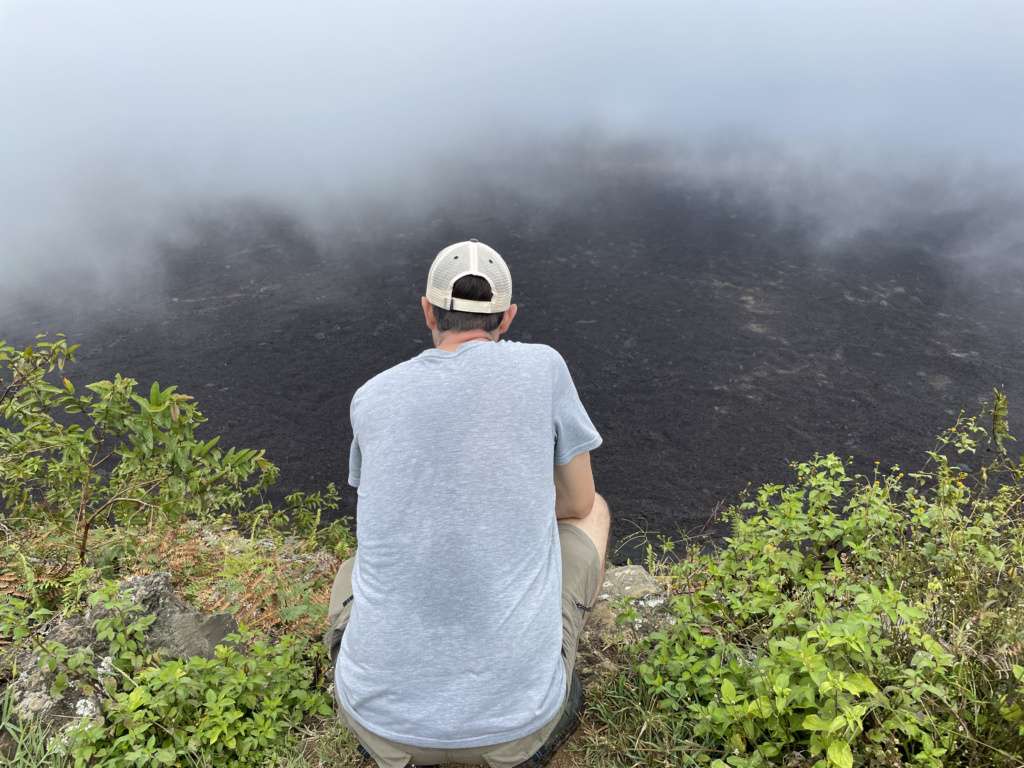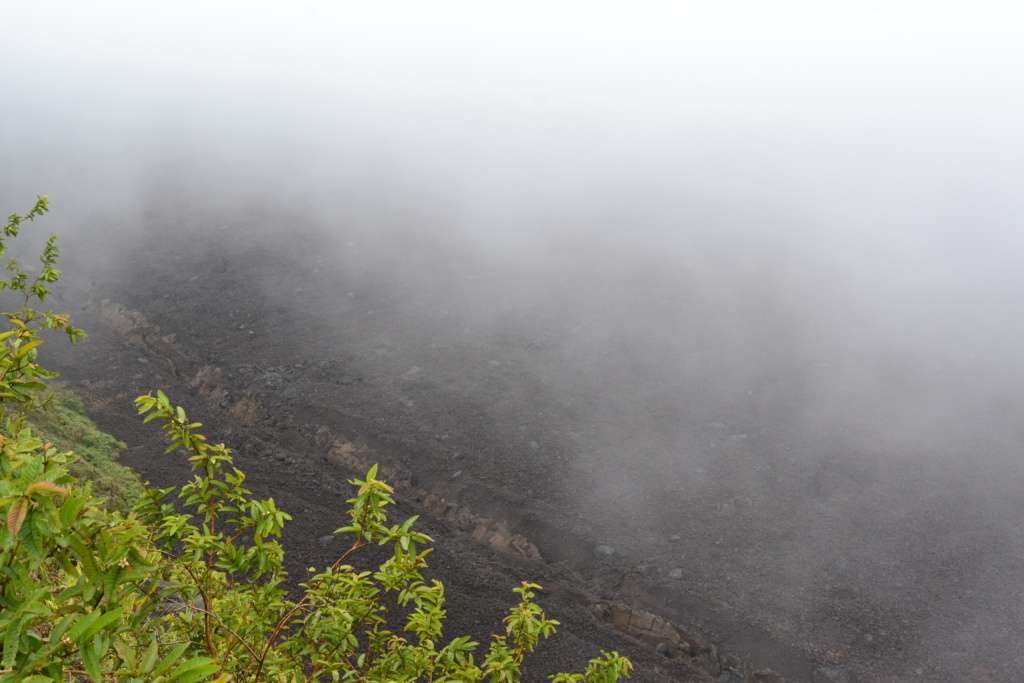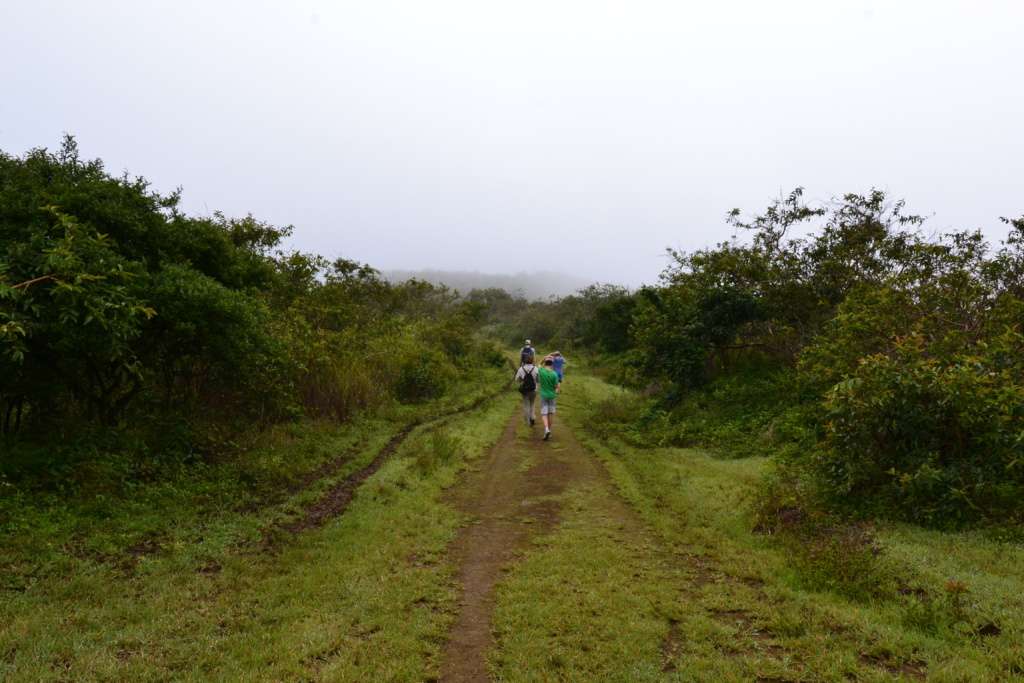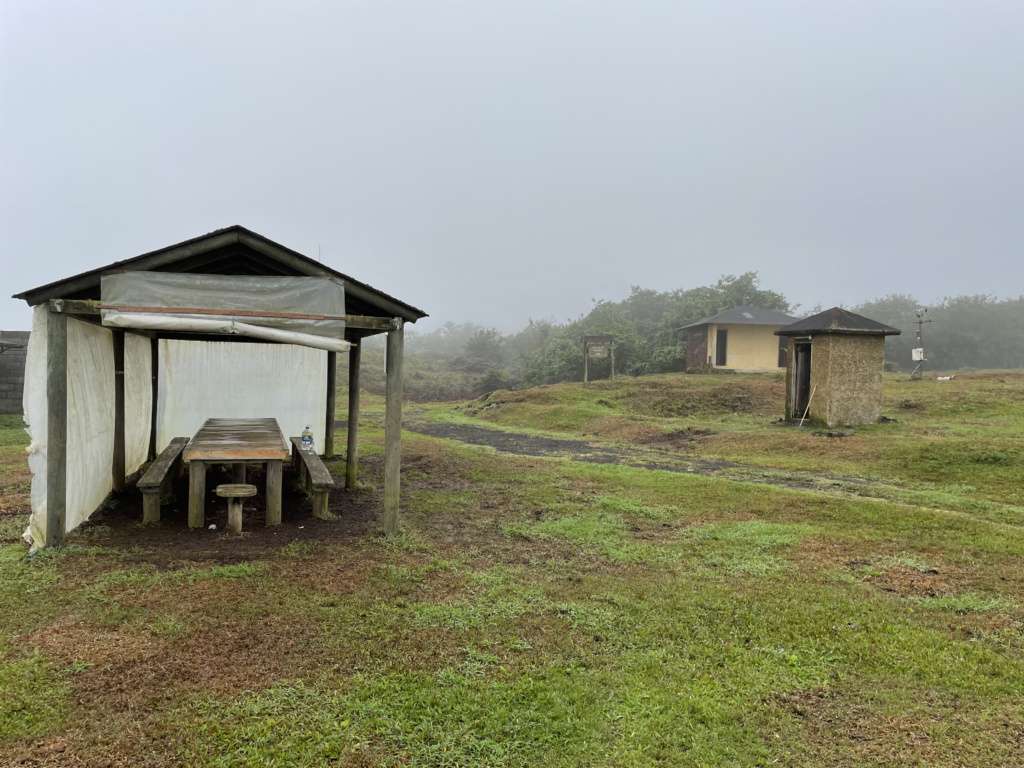Located on southeastern Isabela Island, Sierra Negra is one of the largest and most active volcanoes on the Galapagos. Like the other volcanoes on Isabela, Sierra Negra is a shield volcano featuring a low profile, a wide opening, and gently sloping sides. Its caldera measures more than 6 miles in diameter, making it the second largest in the world. It has erupted 9 times since 1900, with the most recent eruption in 2018.
As part of the package through Iguana Crossing, we had a private tour of Sierra Negra. Our guide and a driver picked us up at the hotel and drove us about 45 minutes to the start of the trail. There was a pretty view looking back over the highlands of Isabela. Clouds hung low in the sky and the area was covered in mist, which is typical of the site. I read one review of the tour on Trip Advisor entitled “Cloudy with a Chance of Volcano”, which perfectly sums up the experience on Sierra Negra.
With no sun and plenty of mist, it was chilly and my kids immediately wished they had listened to me and brought a sweatshirt. 🙂 But even more than that, they wished that they were part of the group that was taking off on horseback. The tour through the hotel was for a hike but I wish I had known that horseback riding was an option because I definitely would have changed to that if we could. The trail is long (8 km each way), muddy, and not especially scenic along the way, and I think we all would have enjoyed it more as a horseback ride than a hike.
The beginning of the trail was a dirt/mud road more than an actual trail. It was a gradual uphill that was more challenging than it looked.
At the beginning of the trail, the land on the right hand side was private property and not part of the national park. It was strange to see cattle grazing behind a barbed wire fence in the thick island vegetation. Though these were domesticated and contained, our guide told us that feral goats and cattle are a problem on the island that threaten some of the native species.
We continued our journey up the path for about an hour before coming to the first lookout point. Unfortunately the fog had not lifted so there was no sweeping view across the caldera.
We could, however, still see down into the caldera and that alone was worth the trip. My oldest son said it was one of the coolest things he had ever seen. The green vegetation along the slope gave way completely to black lava rock at the bottom of the caldera. You could see paths through the rocks that had been formed by lava flows.
Our guide showed us pictures and videos from the 2018 eruption, which lasted almost two months. I had always thought of volcano eruptions as one large, catastrophic event. In reality they can erupt for weeks, months, or even years. On June 26, 2018, a 5.3 magnitude earthquake on Isabela triggered a large eruption that lasted for a day and saw lava flowing from 5 different fissures for distances of up to 7 km. One of the fissures continued to produce lava for 57 days. While seeing a Hollywood-style explosive eruption would be frightening, it must have been incredible to be able to watch the slow flow of lava down to the sea. The nighttime pictures and video of the fiery red lava flowing from the volcano were absolutely stunning.
We continued up the path for another 15 minutes or so to the second viewpoint from the rim of the caldera. We were hoping that the fog would clear by the time we got there but unfortunately we weren’t that lucky. We stayed at the rim for a bit, looking down into the caldera and marveling at the other-worldly surface at the bottom. While we would have loved to see the amazing views across to the other side, this was still a completely unique and fascinating experience that was worthwhile in its own right.
At this point, we had a decision to make. There was still quite a bit of trail ahead of us and the chance of the fog lifting improved as the day went on. But the boys really had no interest in going any further. They were really glad to have had the experience of being on the rim of a volcano and seeing into the caldera. But they didn’t really see a point in continuing along a muddy trail with no real scenery to speak of on the off chance that things might clear up.
Since we were on a private tour, our guide was happy to do whatever we decided as a family. It was great to have that flexibility but I wish she had better explained what was ahead. We all assumed it would just be more of the same – the same trail, the same surroundings, and the same foggy viewpoints with the same slim possibility of catching a clear moment to see across. But what actually was ahead was completely different and would have absolutely been worth the walk.
The trail continues to the lava fields of Volcan Chico, where all vegetation disappears and the landscape is filled with bursts of gold, copper and red against the black lava rock. Seeing pictures afterwards, the surroundings are absolutely stunning and like nothing else on earth. I definitely feel like we missed out by not continuing.
So in our ignorance we turned around and headed back down the muddy trail. We ate a box lunch at the picnic tables at the start of the trail and then the driver met us to take us back to Iguana Crossing.
Sierra Negra is the one Galapagos experience I wish I could have a do-over on, and not even because of the weather (which you can’t control and is par for the course on this tour). First, I wish we had known that horses were an option for the long, somewhat boring trail. That would have been a game changer for the kids. They would have enjoyed the overall experience more and been able to travel the full length of the trail. But short of that, I wish we had at least known enough to push a little further so that we could have seen the wonders of Volcan Chico. As the family travel planner, this is my fault. I could have known more about the tour going in to it. But I think it is important to try to balance having every moment researched and planned with leaving yourself the opportunity to see things for the first time through your own eyes and not previewing everything on the internet first. Sometimes that may mean missing opportunities that you should have known about, but it also means preserving some of the magic and wonder of the things you do get to see. And that seems like a pretty fair trade-off.
